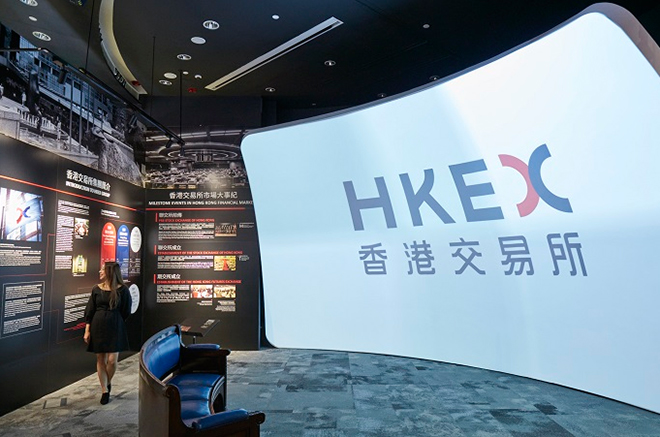S&P Global Offerings
Featured Topics
Featured Products
Events
S&P Global Offerings
Featured Topics
Featured Products
Events
S&P Global Offerings
Featured Topics
Featured Products
Events
Banking & Capital Markets
Economy & Finance
Energy Transition & Sustainability
Technology & Innovation
Podcasts & Newsletters
Banking & Capital Markets
Economy & Finance
Energy Transition & Sustainability
Technology & Innovation
Podcasts & Newsletters
S&P Global Offerings
Featured Topics
Featured Products
Events
24 Feb, 2022

By Rebecca Isjwara
 |
| View of HKEX Connect Hall. |
Hong Kong's stock exchange operator is counting on trading volumes via mutual market access programs with mainland China to grow its business after posting record profits for the fourth year in a row.
Hong Kong Exchanges and Clearing Ltd., or HKEX, expects to leverage mainland
"We're probably going to be in a very good position to manage flows that are coming internationally to [mainland] China and flows that will go from [mainland] China to the international market," Aguzin said on a call with journalists. "When I look at the long term, outlook, it's really, really good. In the short term, it is subject to market gyrations and very hard to anticipate exactly what will happen during 2022."
Record year
Trading volume at HKEX hit a record in 2021, with average daily turnover of HK$166.7 billion, up 29% versus 2020. The connect programs with Shenzhen Stock Exchange and Shanghai Stock Exchange, which allow mainland and Hong Kong investors to trade in each other's markets, helped. Hong Kong investors traded securities worth 27.6 trillion yuan in mainland China in 2021, up 31% from the previous year. The turnover of mainland investors trading in the Hong Kong market rose 70% to reach HK$9.3 trillion in 2021.
HKEX will add more securities to the connect program, including the "progressive inclusion" of exchange-traded funds and other types of assets, Hong Kong's finance secretary, Paul Chan, said in his annual budget speech Feb. 23. Chan also proposed allowing stocks traded by mainland investors in Hong Kong to be denominated in Chinese yuan, as well as exploring enhancements to the wealth management connect scheme in the Greater Bay Area, a megapolis that includes nine cities in mainland China, Hong Kong and Macao.
The strong momentum of Hong Kong investors trading in mainland Chinese markets will continue in the coming quarters, helping HKEX to improve its margins and profitability in 2022, said Bruce Pang, head of macro and strategy research at China Renaissance Securities.
IPO pipeline

The exchange helped 98 companies raise a combined HK$331.4 billion in IPO proceeds in 2021. The largest listing was that of internet software company Kuaishou Technology, which raised HK$48.3 billion, followed by supply chain and logistics service provider JD Logistics Inc. at HK$28.27 billion. Funds raised in 2020 totaled HK$400.2 billion by 154 companies, according to prior announcements.
HKEX also hosted several secondary listings of mainland Chinese companies listed in the U.S., such as that of internet search provider Baidu Inc. and online entertainment software company Bilibili Inc. The exchange expects to attract more biotech and new economy companies, and is evaluating the prospects of listing pre-revenue startups.
HKEX said its IPO pipeline "remains very strong," at around 160 companies hoping to tap the market. These include artificial intelligence, big data, drug discovery and new energy companies seeking secondary or dual listings in Hong Kong. The bourse also received seven applicants under its new framework for special purpose acquisition companies.
Hong Kong remains the preferred listing venue for companies seeking to list outside mainland China, Pang said, noting comments from the exchange operator that "some [mainland] Chinese companies that originally planned to list in the U.S. have applied to list in Hong Kong as well."
China Renaissance has identified 30 such mainland Chinese companies that meet HKEX's criteria to qualify for a potential secondary listing in Hong Kong in 2022 and 2023. "The time frame of homecoming will be the next two years and will likely be front-loaded with a stronger IPO pipeline," Pang said.
As of Feb. 23, US$1 was equivalent to 6.31 Chinese yuan.
